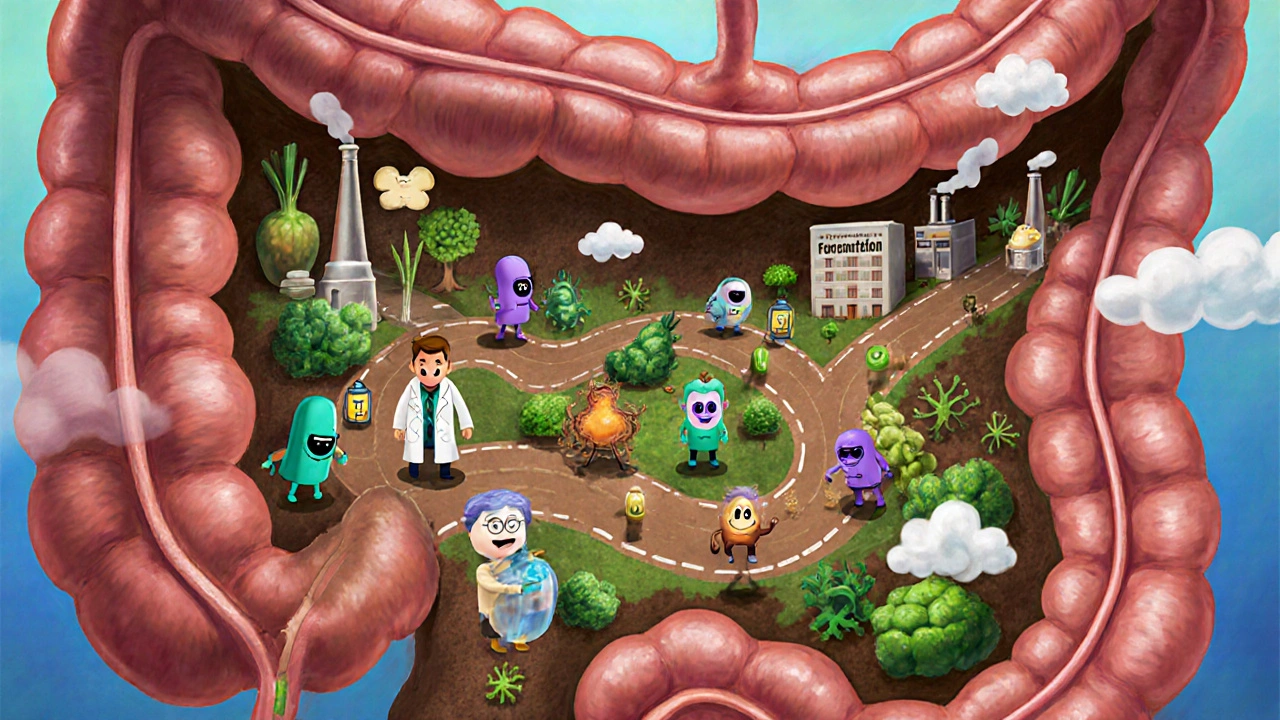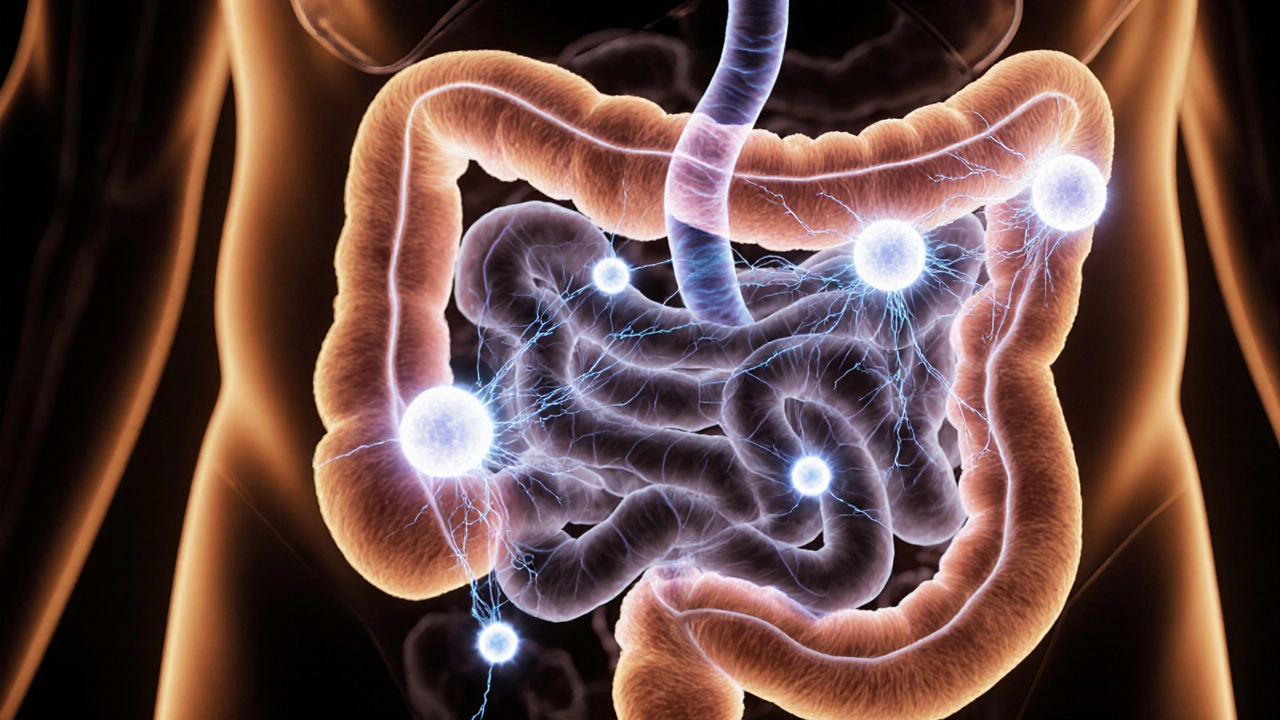Gut Health Nutrition Tracker
Calculate your daily fiber intake and check if you're meeting gut health goals. Based on recommendations from the article.
Fiber Intake
Total: g
Probiotic Intake
Total: servings
Your Personal Recommendations
Ever wonder why a few days of feeling off can turn into weeks of low energy, brain fog, or skin flare‑ups? The missing link is often gut health. Your gut does far more than just digest food; it talks to your immune system, shapes your mood, and even influences your weight. This guide breaks down what gut health really means, why it matters for every part of you, and practical steps you can take right now.
What Is Gut Health?
Gut Health is the state of your digestive system, reflecting how well your gut processes food, absorbs nutrients, and hosts a balanced community of microbes. In plain terms, it’s the ability of your stomach, small intestine, and large intestine to break down what you eat, pull out the good stuff, and keep harmful microbes in check.
Why Gut Health Matters for the Whole Body
Your gut is a highway for signals that travel to every organ. Here are three ways a healthy gut fuels a healthy body:
- Immune regulation: About 70% of immune cells reside in the gut lining, where they learn to distinguish friend from foe.
- Mood and brain function: The gut produces 90% of the body’s serotonin, the “feel‑good” neurotransmitter, via its microbial residents.
- Metabolism and weight management: Certain gut bacteria help break down fibers into short‑chain fatty acids that boost fat burning and reduce inflammation.
When the gut falters, those systems get out of sync, leading to everything from chronic fatigue to autoimmune flare‑ups.
The Gut Microbiome Explained
Microbiome refers to the trillions of bacteria, viruses, fungi, and other microbes that live in your digestive tract. Think of it as a bustling city where each citizen has a job - some break down fibers, others defend against pathogens, and a few even produce vitamins like B12 and K2.
Research from the Human Microbiome Project (2012) shows that a diverse microbiome is linked to lower rates of obesity, diabetes, and even depression. Diversity matters: a gut dominated by just a few species is less resilient to stressors like antibiotics or poor diet.
Common Gut Issues That Signal an Imbalance
Not every tummy ache means a serious problem, but some patterns are red flags:
- Leaky Gut Syndrome describes a condition where the intestinal lining becomes more permeable, allowing toxins and undigested food particles to slip into the bloodstream. Symptoms often include bloating, joint pain, and brain fog.
- Inflammatory Bowel Disease (IBD), which covers Crohn’s disease and ulcerative colitis, involves chronic inflammation of the gut lining. It leads to severe abdominal pain, urgent bowel movements, and weight loss.
- Small‑Intestinal Bacterial Overgrowth (SIBO) occurs when bacteria that usually live in the colon migrate to the small intestine, causing gas, diarrhea, and nutrient malabsorption.
If you experience persistent symptoms for more than three weeks, consider consulting a gastroenterologist.

How to Boost Your Gut Health - Nutrition First
Food is the most powerful tool you have. Here are the three pillars:
- Probiotics are live microorganisms that, when consumed in adequate amounts, confer a health benefit on the host. They can be found in yogurt, kefir, and specialty supplements.
- Prebiotics are non‑digestible fibers that act as food for beneficial gut bacteria. Sources include garlic, onions, bananas, and chicory root.
- Fermented Foods such as sauerkraut, kimchi, and kombucha provide both probiotics and bioactive compounds that support gut lining integrity.
Combining these three creates a synergistic environment where good bugs thrive.
| Aspect | Probiotics | Prebiotics | Fermented Foods |
|---|---|---|---|
| Primary Benefit | Adds live beneficial microbes | Feeds existing beneficial microbes | Both adds microbes and provides fermentable fibers |
| Typical Sources | Yogurt, kefir, supplement caps | Garlic, onions, leeks, asparagus | Sauerkraut, kimchi, kombucha, miso |
| Daily Dose | 1-10 billion CFU (colony‑forming units) | 5-10 g of fiber | ½ cup to 1 cup fermented food |
| Key Strains/Compounds | Lactobacillus, Bifidobacterium | Inulin, fructooligosaccharides (FOS) | Lactic acid, acetic acid, live cultures |
Lifestyle Factors That Keep Your Gut in Shape
Even the best diet can be undone by poor habits. Pay attention to these areas:
- Sleep: 7-9 hours per night supports the gut’s nightly repair cycles. Research links chronic sleep loss to reduced microbial diversity.
- Stress Management: High cortisol levels increase gut permeability. Practices like deep breathing, meditation, or a short walk can lower stress hormones within minutes.
- Regular Physical Activity: Moderate exercise (e.g., brisk walking, cycling) boosts the flow of beneficial bacteria and promotes regular bowel movements.
- Avoid Unnecessary Antibiotics: While lifesaving when needed, antibiotics can wipe out up to 90% of gut bacteria. If prescribed, ask your doctor about a probiotic protocol.
Supplements and Practical Tips
If you struggle to get enough microbes through food alone, consider these proven options:
- Digestive Enzymes help break down proteins, fats, and carbs, reducing gut irritation for people with lactose or gluten sensitivity.
- High‑quality Probiotic supplements containing multiple strains (e.g., Lactobacillus rhamnosus, Bifidobacterium longum) taken with a meal for better survival through stomach acid.
- Short-Chain Fatty Acids (SCFAs) such as butyrate can be taken as a supplement to strengthen the gut lining, especially for those with leaky gut symptoms.
Start with a low dose and increase gradually to avoid gas or bloating.

Tracking Progress and When to Seek Professional Help
Gut health isn’t a one‑time fix; it’s a daily habit. Here’s how to gauge improvement:
- Stool Consistency: Aim for a smooth, medium‑brown log (type 3-4 on the Bristol Stool Chart).
- Energy Levels: Notice if morning fog lifts after a few weeks of dietary changes.
- Skin Clarity: Reduced breakouts can signal a calmer gut‑skin axis.
- Medical Tests: If symptoms persist, ask for a comprehensive stool analysis to check microbial diversity.
When you see red flags-persistent pain, unexplained weight loss, blood in stool-book an appointment with a gastroenterologist.
Quick Gut‑Health Checklist
- Eat at least 25 g of fiber daily from vegetables, fruits, and whole grains.
- Include a probiotic food or supplement each day.
- Limit processed sugars and artificial sweeteners.
- Stay hydrated: 2-3 L of water supports digestion.
- Prioritize 7‑9 hours of sleep and daily stress‑relief routines.
Frequently Asked Questions
How long does it take to see improvements in gut health?
Most people notice better digestion, more regular stools, and reduced bloating within 2-4 weeks of consistent diet and lifestyle changes. Full microbial diversity shifts can take 3-6 months.
Are all probiotic supplements the same?
No. Effective probiotics contain multiple strains, a minimum of 1 billion CFU per dose, and are shelf‑stable or refrigerated. Look for third‑party testing and strain specificity.
Can I fix gut problems without medication?
Mild to moderate imbalances often respond to dietary fiber, probiotics, and stress reduction. Severe cases like IBD usually require medical therapy in addition to lifestyle support.
Is fermented food safe for everyone?
Most healthy adults tolerate fermented foods well. People with histamine intolerance or a weakened immune system should start with small portions and monitor reactions.
How do antibiotics affect my gut microbiome?
Broad‑spectrum antibiotics can wipe out up to 90% of gut bacteria, reducing diversity for weeks or months. Taking a probiotic during and after a course helps reseed beneficial strains.







